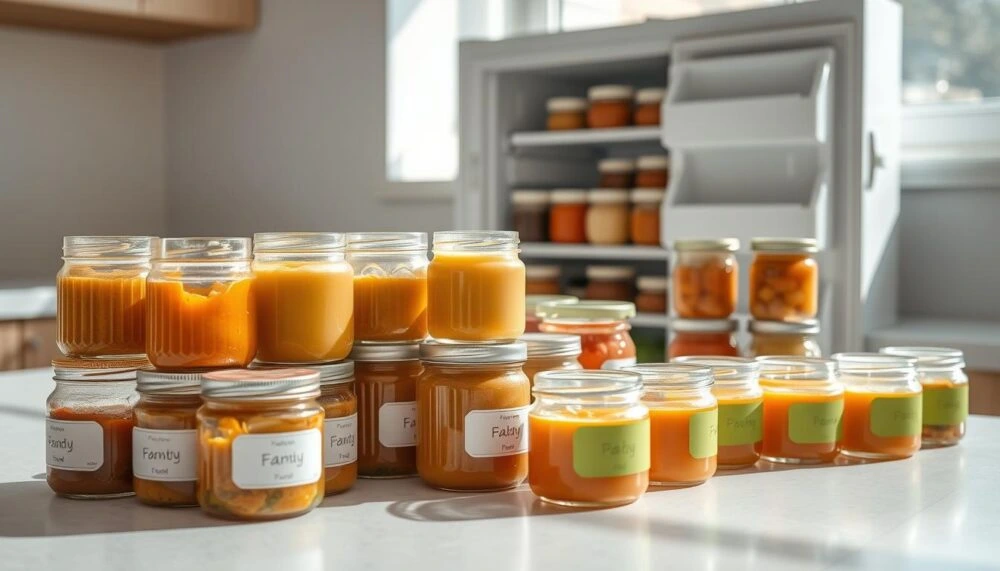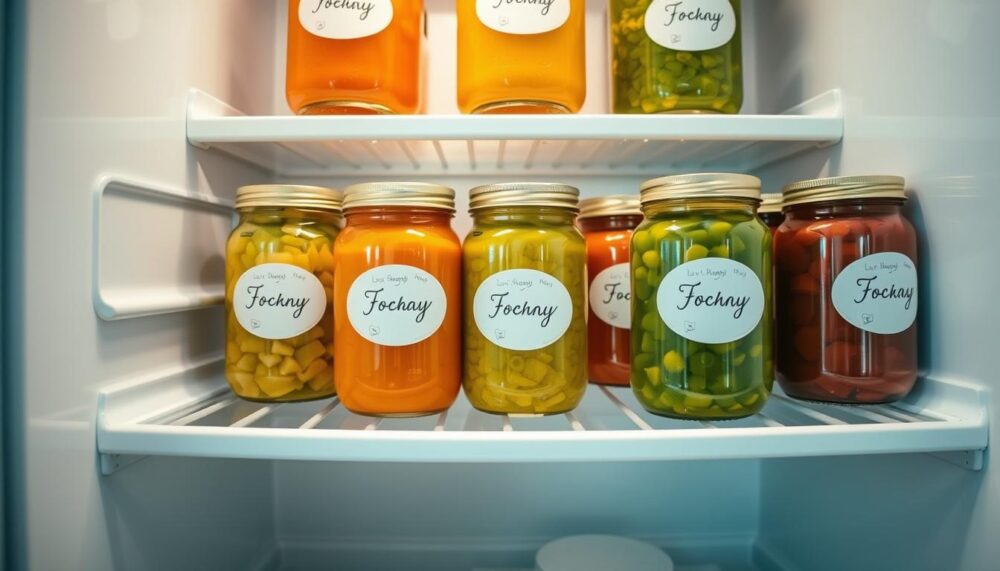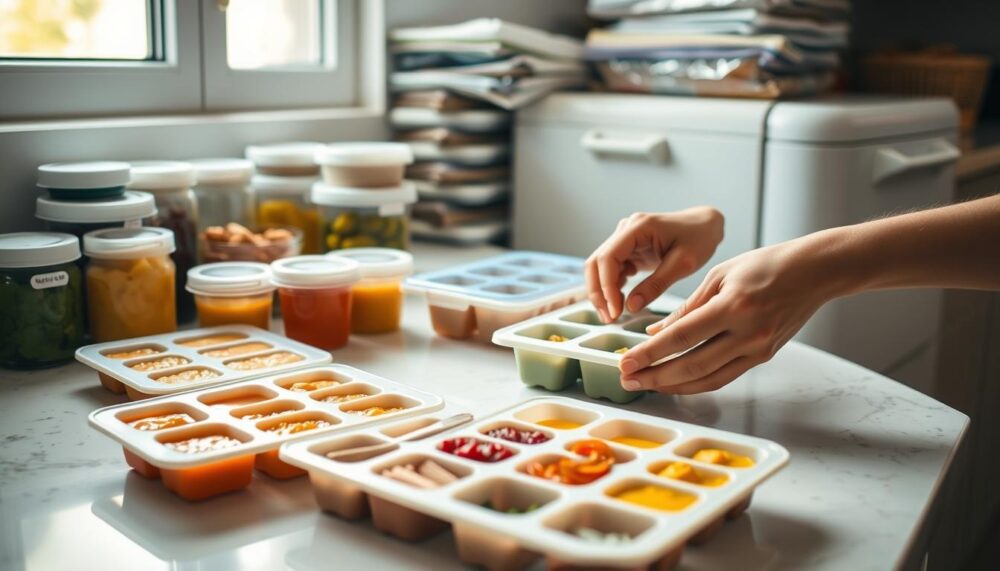
As a parent, keeping homemade baby food safe is key. It helps keep the food fresh and full of nutrients. I’ll show you how to freeze homemade baby food safely. This way, your baby stays healthy and happy.
Introduction to Freezing Homemade Baby Food
Freezing homemade baby food is a smart move for parents. It keeps the nutrients in and makes meals fresh. I’ll share the basics of freezing baby food and how to keep it top-notch.
Key Takeaways
- Proper storage of homemade baby food is essential for maintaining its quality and nutritional value.
- Freezing homemade baby food is a great way to preserve its nutritional value.
- Learning how to store homemade baby food in freezer can help prevent spoilage and foodborne illnesses.
- Storing homemade baby food requires careful planning and attention to detail.
- Freezing homemade baby food can be a convenient and time-saving way to prepare meals for your baby.
- It’s essential to follow safe food handling practices when storing and freezing homemade baby food.
Benefits of Freezing Homemade Baby Food
Freezing homemade baby food is a smart and budget-friendly way to plan meals. It keeps your baby’s meals nutritious and safe. Freezing helps keep the food’s nutritional value intact.
Freezing your baby’s food ensures the nutrients and flavors stay locked in. This is key for babies, who need a balanced diet to grow. By freezing wisely, you make healthy meals that are also simple to make.

Cost-Effective Meal Planning
Freezing baby food saves time and money. It helps you avoid food waste and cuts down on grocery bills. This is great for busy parents who need quick meal solutions.
Nutritional Value Preservation
Freezing baby food also keeps its nutrients and flavors in. This means your baby gets the nutrients they need to grow. It’s vital for a baby’s health to have a balanced diet.
Time-Saving Advantages
Lastly, freezing baby food saves you time. You can thaw and serve meals quickly. This is perfect for parents with tight schedules. By freezing smartly, you make healthy meals easy to prepare.
Essential Tools and Supplies for Freezing Baby Food
Freezing baby food needs the right tools and supplies. You’ll need airtight containers, ice cube trays, and labels. Make sure these are BPA-free for your baby’s safety.
Some key items for freezing baby food are:
- Airtight containers with tight-fitting lids
- Ice cube trays for portioning and freezing
- Labels and markers for dating and identifying frozen food
- BPA-free utensils and equipment for preparing and handling baby food
Using the right tools makes storing frozen baby food easier. These items keep your baby’s food safe and healthy.

Always put your baby’s safety first when preparing their food. With the right tools, you can store pureed baby food safely in the freezer.
| Tool/Supply | Description |
|---|---|
| Airtight Containers | For storing frozen baby food |
| Ice Cube Trays | For portioning and freezing baby food |
| Labels and Markers | For dating and identifying frozen food |
Preparing Baby Food for Freezer Storage
Before freezing homemade baby food, it’s key to prepare it right. This ensures safety and quality. Cool the food to room temperature to stop bacteria growth. This is a vital step in storing homemade baby food safely.
After cooling, portion the food. Use an ice cube tray for small, freezing homemade baby food portions. This makes thawing and serving easy, saving time and reducing waste. Portioning is a major part of homemade baby food storage tips.
- Use airtight containers to prevent contamination and freezer burn
- Label each container with the date and contents
- Store the containers in a single layer to prevent them from sticking together
By following thesehomemade baby food storage tips, your baby’s food stays safe and healthy. Always focus on cooling, portioning, and labeling whenstoring homemade baby foodin the freezer.
How to Store Homemade Baby Food in Freezer Safely
Storing homemade baby food in the freezer needs some knowledge and care. It’s important to follow safe storage tips to avoid contamination and foodborne illnesses. When freezing homemade baby food, the right container and storage temperature are key.
To keep storing homemade baby food safe and quality, use airtight, BPA-free containers or freezer bags. Label them with the date and what’s inside. This makes it easy to keep track of your freezer’s contents. Also, store them away from strong-smelling foods to prevent cross-contamination.
Some important tips for freezing homemade baby food include: * Use ice cube trays for individual portions * Move frozen cubes to airtight containers or freezer bags for longer storage * Keep the freezer at 0°F (-18°C) or below
By following these tips and precautions, parents can keep their homemade baby food safe and nutritious. Always check for spoilage before serving. And, reheat it safely to avoid foodborne illnesses.
Best Containers for Freezing Baby Food
Choosing the right containers for freezing homemade baby food is key. As a parent, I aim for containers that are safe, keep food quality high, and are easy to clean. Airtight, durable, and easy-to-clean containers are the best for freezing baby food.
There are many options like ice cube trays, storage containers, glass, plastic, and silicone. Each has its own benefits and drawbacks. For instance, ice cube trays are perfect for small portions, while storage containers work better for larger amounts. It’s important to pick the right one to keep food fresh and safe.
Comparison of Container Options
- Ice cube trays: convenient for small portions, but may not be airtight
- Storage containers: great for larger quantities, but may take up more space in the freezer
- Glass containers: non-toxic and eco-friendly, but may be heavier and more expensive
- Plastic containers: lightweight and affordable, but may contain BPA and other chemicals
- Silicone containers: flexible and easy to clean, but may not be as durable as other options
By using the right containers and following best practices, you can keep your baby’s food safe and nutritious. Always label and date the containers. Store them at 0°F (-18°C) or below to prevent spoilage and foodborne illness.
Temperature and Timeline Guidelines
When you freeze pureed baby food, it’s key to follow certain rules. This ensures the food stays safe and healthy for your little one. The freezer must be at 0°F (-18°C) or colder. This stops bacteria from growing and keeps the food’s quality.
Freezing baby food for later needs some planning. You want to use it within 3-6 months. Here are some tips:
- Label and date each container or bag of frozen baby food to keep track of how long it’s been stored.
- Store frozen baby food in airtight, moisture-proof containers or freezer bags to prevent freezer burn and contamination.
- Keep the freezer at a consistent temperature to prevent temperature fluctuations that can affect the quality of the food.
By sticking to these guidelines, you can keep your baby’s food safe and nutritious. Always check the food for spoilage before serving. If it’s past its safe time, throw it away.
For more info on freezing baby food, check out this table:
| Food Type | Storage Time | Storage Method |
|---|---|---|
| Pureed Fruits and Vegetables | 3-6 months | Airtight containers or freezer bags |
| Cooked Meats and Poultry | 2-3 months | Airtight containers or freezer bags |
| Fish and Seafood | 1-2 months | Airtight containers or freezer bags |
Thawing and Serving Frozen Baby Food
Thawing and serving frozen baby food safely is key. You want to make sure your baby’s food is nutritious and safe. By using homemade baby food storage tips, you can keep the food quality and safety high.
To thaw frozen baby food, you can use the fridge, cold water, or the microwave. It’s important to follow storing homemade baby food guidelines to avoid bacterial growth. Here are some safe thawing methods:
- Refrigerator thawing: Place the frozen baby food in the fridge overnight or for a few hours.
- Cold water thawing: Put the frozen baby food in cold water, changing it every 30 minutes.
- Microwave thawing: Use the defrost function on your microwave, following the instructions.
After thawing, reheat the baby food to 165°F (74°C) to ensure safety. You can use the microwave or stove to reheat. Stir well and check the temperature before serving.
By following these homemade baby food storage tips, you can keep your baby’s food safe, nutritious, and tasty. Always prioritize food safety and handle frozen baby food carefully to avoid contamination and foodborne illnesses.
| Defrosting Method | Time | Temperature |
|---|---|---|
| Refrigerator | Overnight or several hours | 40°F (4°C) or below |
| Cold Water | 30 minutes to 2 hours | 40°F (4°C) or below |
| Microwave | 30 seconds to 2 minutes | 165°F (74°C) or above |
Common Mistakes to Avoid When Freezing Baby Food
Freezing homemade baby food can be tricky. There are mistakes that can harm the food’s safety and quality. Knowing these mistakes helps keep your baby’s food safe and healthy. One big mistake is not cooling the food right. This can let bacteria grow.
Another mistake is not labeling the food well. This makes it hard to know how long it’s been in the freezer. When freezing homemade baby food, label each container with the date and type. This helps you keep track of what you have.
Storing food wrong is another issue. It can make the food contaminated or spoiled. To avoid these problems, cool the food safely, label it, and use airtight containers. These steps help keep your baby’s food safe and nutritious.
Some other mistakes to avoid include:
- Not using airtight containers, which can cause the food to become contaminated or spoiled
- Not labeling the containers, which can make it difficult to keep track of how long the food has been stored
- Not cooling the food to a safe temperature, which can cause the growth of bacteria and other microorganisms
By knowing these mistakes and avoiding them, you can keep your baby’s food safe and healthy. Always follow the right steps for storing homemade baby food in the freezer. This ensures the best results.
Conclusion: Mastering Homemade Baby Food Storage
By following the tips in this guide, you can store homemade baby food in the freezer like a pro. It’s all about keeping food safe, nutritious, and easy to access.
Knowing how to freeze baby food right ensures it stays fresh and full of nutrients. This way, you save money, time, and keep your baby’s meals healthy.
Use the right containers, follow temperature and time rules, and thaw and reheat safely. With careful storage, you can give your baby delicious, homemade meals anytime.
FAQ
How long can I store homemade baby food in the freezer?
You can store homemade baby food in the freezer for 2-3 months. Make sure to label the containers with the date they were frozen. This helps you use the oldest food first.
What are the best containers for freezing baby food?
Choose containers that are BPA-free, airtight, and can handle freezing. Good options include ice cube trays, silicone molds, and glass or plastic containers.
How do I properly thaw and reheat frozen baby food?
To thaw, place the frozen food in the fridge overnight. To reheat, use a saucepan on the stove or the microwave. Stir well and check the temperature before serving.
What are some common mistakes to avoid when freezing baby food?
Avoid not cooling food completely before freezing and overfilling containers. Also, don’t refreeze thawed food. Always follow best practices for safety and quality.
How do I store different types of homemade baby food in the freezer?
Use ice cube trays or small containers for purees and mashes. For meats, veggies, and grains, use larger containers. Always label each container with what’s inside and the date.
Can I mix different types of homemade baby food in the same container?
It’s best to freeze each type separately. This way, you can thaw and serve just the right amount. But, you can mix small portions if freezer space is tight.
How do I maintain the nutritional value of homemade baby food in the freezer?
Use fresh, quality ingredients and cool food quickly before freezing. Avoid overcooking. Storing in airtight containers also helps keep nutrients in.